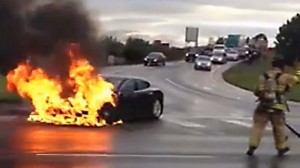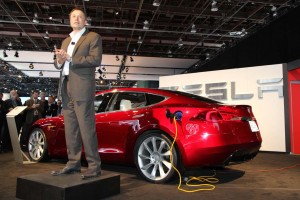Following the third fire in barely six weeks, the National Highway Traffic Safety Administration has opened a formal investigation of the Tesla Model S electric vehicle.
Two of the fires occurred after the cars struck large pieces of road debris, penetrating their battery compartments and apparently causing short circuits. A third blaze followed a high-speed crash. In all instances, drivers were able to escape the vehicles without injury.
But concerns about the fires have contributed to a recent run on start-up carmaker Tesla’s once high-flying stock.
A total of 13,000 of the Model S battery cars sold in the U.S. are directly covered by the investigation though if NHTSA were to order a recall or some other action it might also impact an additional 6,000 vehicles shipped abroad since sales of the Model S began in July 2012.
For his part, Tesla founder and CEO Elon Musk had said the maker had no intention of ordering a recall in the days after the third Model S fired was reported. But he took a more positive tone on Monday, stating in a blog post that Tesla had actually requested the NHTSA investigation in order “to examine the potential risks associated with undercarriage strikes.”
Musk, who frequently blogs and tweets to express both his personal and Tesla’s corporate stand on various issues, appeared to be more open to action should the NHTSA investigation discover a specific design problem with the new Model S.
“While we think it is highly unlikely, if something is discovered that would result in a material improvement in occupant fire safety, we will immediately apply that change to new cars and offer it as a free retrofit to all existing cars,” the South African-born executive wrote.
(Model S owner insists he’ll buy another after fire. Click Here to read more.)
Musk also wrote that Tesla is taking several steps on its own to deal with potential problems with vehicle fires and, in particular, those caused by striking road debris. First, he indicated the maker has already used direct radio links to Model S sedans now on the road to update their control software. That will result in greater ground clearance to reduce the possibility of road debris penetrating the half inch of armor that protects the bottom of the battery pack.
In addition, Musk wrote that, “to reinforce how strongly we feel about the low risk of fire in our cars, we will be amending our warranty policy to cover damage due to a fire, even if due to driver error. Unless a Model S owner actively tries to destroy the car, they are covered.”
Whether the new NHTSA investigation will, in fact, lead to any action by NHTSA remains to be seen but Musk had previously criticized the media coverage of the three Model S fires. The first report came in late September, shortly after Tesla stock peaked at $194.50, a roughly 500% jump since just the beginning of the year. As of the end of the trading day on Monday, it had slumped to $121.58.
“If a false perception about the safety of electric cars is allowed to linger, it will delay the advent of sustainable transport and increase the risk of global climate change, with potentially disastrous consequences worldwide. That cannot be allowed to happen,” Musk wrote on Monday.
He repeated earlier comments comparing the safety of batteries to gasoline-powered vehicles involved in over 100,000 fires annually in the U.S. alone.
Musk is likely not the only one who will be watching the NHTSA investigation closely. A growing number of manufacturers have introduced lithium-powered battery-electric vehicles and plug-in hybrids over the last two years, with still more models to be announced just this week during simultaneous auto shows in Los Angeles and Tokyo.
(VW debuting two new battery cars at LA Auto Show. Click Here for more.)
Should NHTSA find fault with the underlying battery technology used by Tesla that could raise concerns – at least in the minds of potential buyers – with all lithium-based vehicles. It would not be the first time that the spotlight has fallen on the most advanced of the battery technologies currently in widespread use. A Sony factory fire and the crash of a cargo plane in the Mideast are among incidents connected to lithium-ion battery fires.
Both the September fire and another on November 6th in Smyrna, Tennessee – ironically, near the factory producing the Nissan Leaf electric vehicle – both resulted from large chunks of debris penetrating the battery packs mounted below the passenger compartment. In both cases, owners reported their vehicles issued warnings giving them ample time to escape without injury. The third incident occurred after a high-speed crash in Mexico.
Concerns about the Model S battery pack are not the only reason Tesla stock has fallen sharply in recent weeks. The maker has also been hit by negative comments from several key analysts who warned that its shares had already climbed well above a sustainable level.
(Kia promises 124 miles of range from new Soul EV. Click Here for details.)



Musk may have figured it’s better to accept than to be forced to comply.
He’s naive to not expect a safety perception to remain when there is good reason for concern. He may not like what NHTSA has to say in their report.